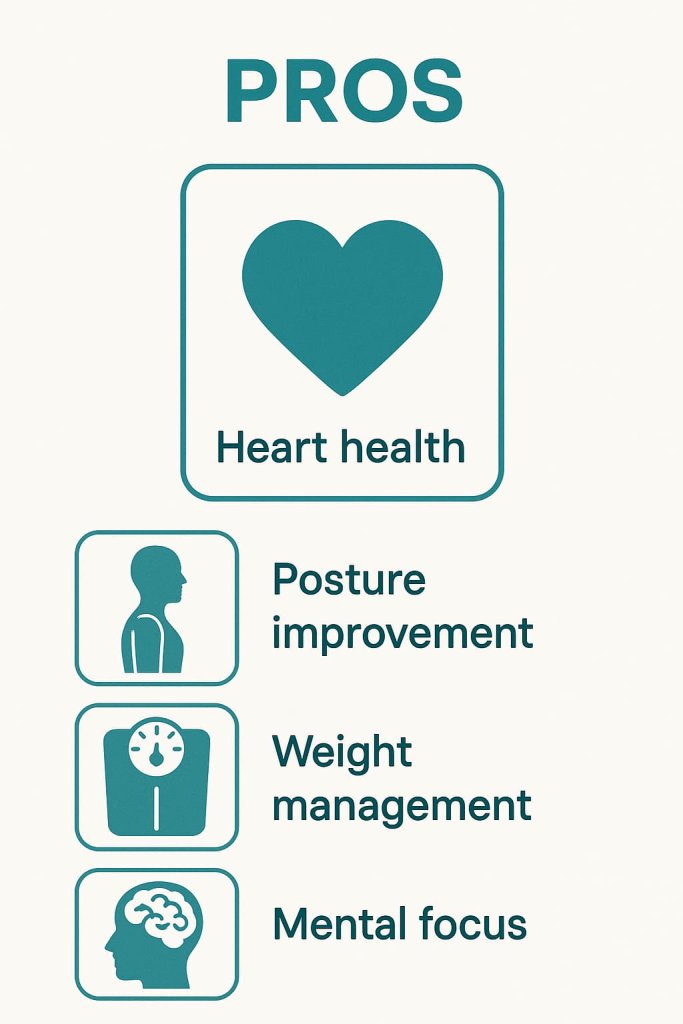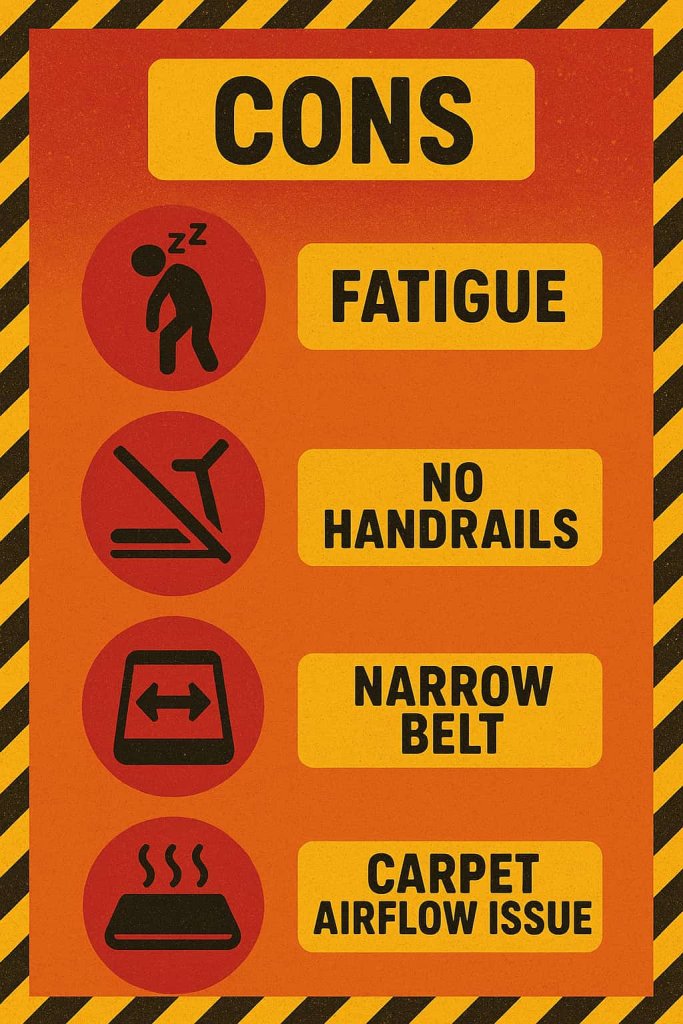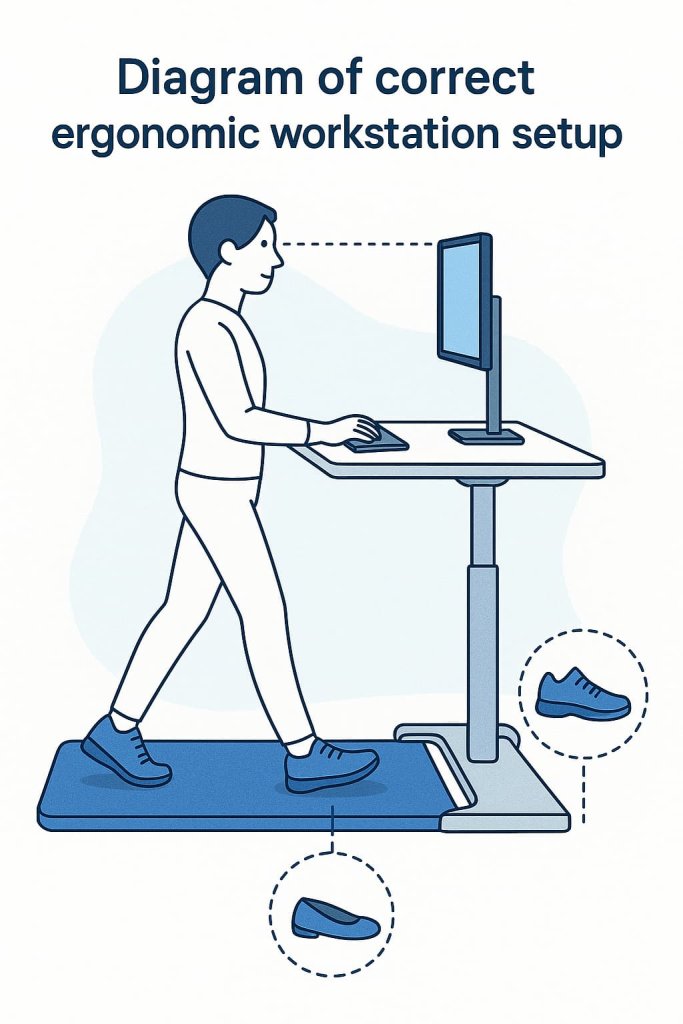Yes — walking pads can be worth buying if you want to stay active while working or relaxing, but they also come with important limitations you should understand first.
A walking pad, also called an under-desk treadmill, offers a convenient way to move more throughout the day without needing a gym or large space. It’s an increasingly popular choice for remote workers, students, and anyone looking to break up long hours of sitting.

However, before you invest, it’s important to evaluate both the advantages and drawbacks — including health effects, safety, space, and cost — to ensure it fits your lifestyle and goals.
This guide combines expert data from the Cleveland Clinic, ACE Fitness, WebMD, and Consumer Reports to give you a complete, fact-based overview.
What Is a Walking Pad?
A walking pad is a compact, motorized treadmill designed for low-speed walking indoors. Unlike traditional treadmills, it typically has no handrails or incline and can easily slide under a desk or bed.
The main purpose is to encourage movement during otherwise sedentary activities like working, reading, or watching TV. Many models include remote controls or Bluetooth apps for easy speed adjustment.
Average Walking Pad Specifications
| Feature | Typical Range | Details |
|---|---|---|
| Speed Range | 0.5–4 mph | For light to moderate walking only |
| Belt Width | 15–18 inches | Narrower than standard treadmills |
| Noise Level | 40–60 dB | Quiet enough for office use |
| Weight Capacity | 220–265 lbs | Depends on model and motor strength |
| Price Range | $200–$800 | Budget-friendly compared to full treadmills |
According to the Cleveland Clinic, walking pads are best for people who sit for extended periods and want a simple way to increase daily movement, circulation, and energy levels.
The Pros of Using a Walking Pad

1. Encourages More Daily Movement
Walking pads help combat sedentary behavior, one of the biggest health challenges of modern life.
The American Council on Exercise (ACE) emphasizes that even slow walking boosts circulation, supports heart function, and reduces stiffness in muscles and joints.
Sitting for more than 6–8 hours a day is associated with increased risk of cardiovascular disease, but short bouts of walking can help counter those effects.
Best practice: Start with 15–20 minutes of walking each hour, alternating between sitting, standing, and walking.
2. Supports Weight Management
Walking burns calories steadily without joint strain.
At 2 mph, a 150-lb person can burn about 150–200 calories per hour, according to Harvard Health Publishing. Over a workweek, that can add up to 700–1,000 extra calories burned — equivalent to several gym sessions’ worth of energy expenditure.
3. Boosts Focus and Productivity
Light movement improves brain oxygenation and focus.
WebMD reports that walking promotes alertness, better mood, and reduced stress — ideal for professionals working long desk hours. Many users find they type and brainstorm more effectively while walking at a slow pace (1–1.5 mph).
4. Compact, Portable, and Space-Saving
Walking pads typically weigh under 60 pounds and fold in half for easy storage.
They’re perfect for small apartments or home offices, allowing users to stay active without needing a dedicated gym area. Unlike treadmills, they can be stored under a bed, sofa, or desk.
5. Low-Impact and Joint-Friendly
The walking pad’s cushioned belt reduces stress on knees, hips, and ankles.
It’s especially beneficial for:
- Older adults seeking gentle movement
- People recovering from mild joint issues
- Those wanting exercise with minimal impact
This makes it an inclusive option for nearly all fitness levels.
6. Encourages Better Posture and Blood Flow
Standing and walking periodically prevents the poor posture associated with sitting for hours.
ACE Fitness recommends alternating between sitting, standing, and walking to help maintain proper spinal alignment and reduce back or neck discomfort.
The Cons of Using a Walking Pad

1. Limited Exercise Intensity
Most walking pads have a maximum speed of 3–4 mph, meaning they aren’t suitable for running or intense cardio workouts.
If your fitness goal is endurance or high-intensity training, a full treadmill or outdoor workout will be more effective.
2. Postural Fatigue and Overuse Risks
Typing or reading while walking can lead to fatigue in your legs, shoulders, and lower back — especially if the desk height isn’t properly adjusted.
ACE Fitness advises walking in shorter sessions (20–40 minutes) and maintaining ergonomic alignment: elbows at 90°, screen at eye level, and shoulders relaxed.
3. Fewer Safety Features
Walking pads usually lack handrails and emergency stop cords, making balance crucial.
Consumer Reports warns that while they’re safe at slow speeds, distractions — like texting or typing quickly — can increase the risk of minor slips or missteps.
Safety tip: Always wear shoes with traction and avoid walking barefoot or in socks.
4. Narrow Belt and Limited Stride Room
The smaller belt width (16–18 inches) can feel restrictive for taller users or those with longer strides.
This makes it important to maintain balance and start at slower speeds.
5. Possible Noise and Vibration
Although quieter than standard treadmills, vibration can occur on thin flooring or carpeted surfaces.
A PVC treadmill mat under the walking pad minimizes vibration, protects flooring, and improves motor airflow.
6. Not a Full Replacement for Outdoor Activity
Indoor walking lacks the sunlight exposure and terrain variation of outdoor walking.
The American Heart Association reminds users that outdoor walking provides additional benefits — including vitamin D synthesis and improved balance from uneven surfaces.
Health and Safety Guidelines

To get the best results from your walking pad — and to prevent strain or accidents — it’s essential to follow evidence-based safety practices recommended by fitness experts and official agencies.
1. Start Slow and Build Gradually
Begin at a comfortable speed of 1–2 mph, especially if you’re new to walking pads. Gradually increase your pace as your balance and endurance improve. Avoid sudden speed changes while multitasking, as this may affect stability.
2. Maintain Proper Posture
Position your monitor at eye level and keep your shoulders relaxed to prevent neck and upper back strain. Maintain a natural stride — don’t overstep or lean forward when walking.
3. Alternate Between Sitting, Standing, and Walking
Experts recommend switching positions every 30–60 minutes to promote healthy circulation and prevent fatigue. Use your walking pad in short sessions throughout the day rather than continuously for hours.
4. Wear Proper Footwear
Always wear non-slip, supportive walking shoes. Avoid slippers, sandals, socks, or walking barefoot, as these increase the risk of slipping or discomfort during extended use.
5. Keep the Area Clear
Ensure the space around the walking pad is free of cords, furniture, or clutter. A clean, open area prevents tripping hazards and provides enough clearance for the walking belt to move freely.
6. Use a Flat, Stable Surface
Place your walking pad on a level surface — ideally with a rubber or PVC treadmill mat underneath. This helps absorb vibration, protects flooring, and ensures proper airflow for the motor.
7. Clean and Maintain Regularly
Inspect and clean the belt weekly, and lubricate it every 1–3 months (or as directed by the manufacturer). Proper maintenance prevents belt friction, overheating, and premature motor wear.
Official Safety Resource
For detailed safety practices on motorized walking devices, visit the U.S. Consumer Product Safety Commission (CPSC) official resource:
👉 CPSC – Voluntary Standards for Powered Treadmills
The CPSC outlines recognized safety standards for powered treadmills and home exercise equipment, covering mechanical stability, user injury prevention, and product maintenance — all of which apply to walking pads used in homes and offices.
Walking Pad vs. Traditional Treadmill
| Feature | Walking Pad | Traditional Treadmill |
|---|---|---|
| Purpose | Daily low-intensity walking | Cardio & running |
| Speed Range | 0.5–4 mph | Up to 12 mph |
| Incline Option | Rare | Common |
| Noise Level | 40–60 dB | 60–80 dB |
| Storage | Foldable, portable | Stationary |
| Safety Features | Minimal | Rails, stop key |
| Average Price | $200–$800 | $700–$2,500+ |
| Ideal For | Home/office use | Dedicated exercise rooms |
Summary: Walking pads excel for light, consistent movement and productivity. They’re not a full treadmill replacement but an effective supplement for daily health.
Alternatives to Walking Pads
If you prefer more variety or higher intensity:
- Standing desks: Reduce sitting time without motion.
- Mini steppers: Compact and provide light resistance.
- Compact ellipticals: Engage both upper and lower body.
- Outdoor walking: Adds sunlight, fresh air, and mental refreshment.
The American Heart Association ranks walking — indoors or outdoors — as one of the most accessible and beneficial lifelong exercises.
Who Should (and Shouldn’t) Use a Walking Pad
Best suited for:
- Remote workers or students
- Office employees seeking light daily activity
- Seniors or those recovering from mild injuries
- People with limited home space
Not ideal for:
- Runners or HIIT athletes
- Users needing high-speed workouts
- Individuals with significant balance issues
Related Posts:
- 7 Best Walking Pads for Home & Office Fitness – Stay Active Indoors
- 5 Best Under Desk Walking Pads: Stay Fit While You Work
- 5 Best Folding Walking Pads for Home & Office
- 5 Best Walking Pads with Incline
- 5 Best Walking Pads with Handle for Home, Office & Seniors
Common FAQs
1. Do walking pads help with weight loss?
Yes. When used consistently, they help burn calories and prevent sedentary weight gain, though results depend on diet and duration.
2. Can I use a walking pad on carpet?
Yes, but use a treadmill mat for stability and to prevent motor overheating.
3. Are walking pads safe for older adults?
Yes, at low speeds (1–2 mph) and with supervision if needed. Look for models with remote stop features.
4. How long should I walk per day?
Experts recommend 30–60 minutes daily, broken into shorter sessions to prevent fatigue.
5. Are walking pads noisy?
No, most operate between 45–55 decibels — similar to casual conversation.
6. How long does a walking pad last?
Typically 3–5 years, depending on usage, maintenance, and build quality.
7. Can a walking pad replace outdoor exercise?
Not entirely — outdoor activity provides mental and environmental benefits that indoor devices can’t fully replicate.
Conclusion
A walking pad is worth buying if your goal is to stay active, reduce sitting time, and improve focus — especially if you work from home or in an office. It’s convenient, space-saving, and effective for steady movement.
However, it’s not designed for intense cardio or strength training. For best results, combine walking pad sessions with outdoor walks, stretching, and resistance training to maintain balanced fitness.
Final verdict:
- ✅ Excellent for low-impact daily movement and productivity.
- ⚠️ Limited for advanced cardio or long-distance training.
- 💡 Best used as part of an overall active lifestyle.
